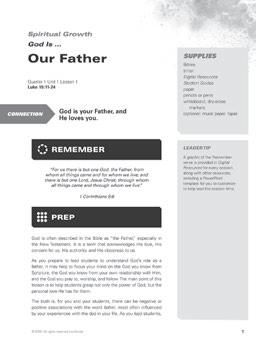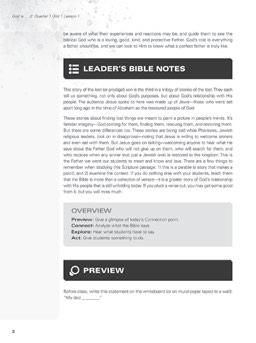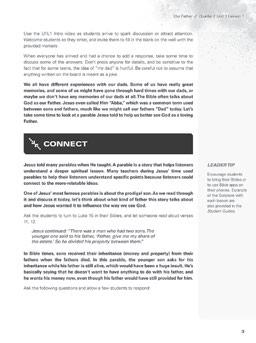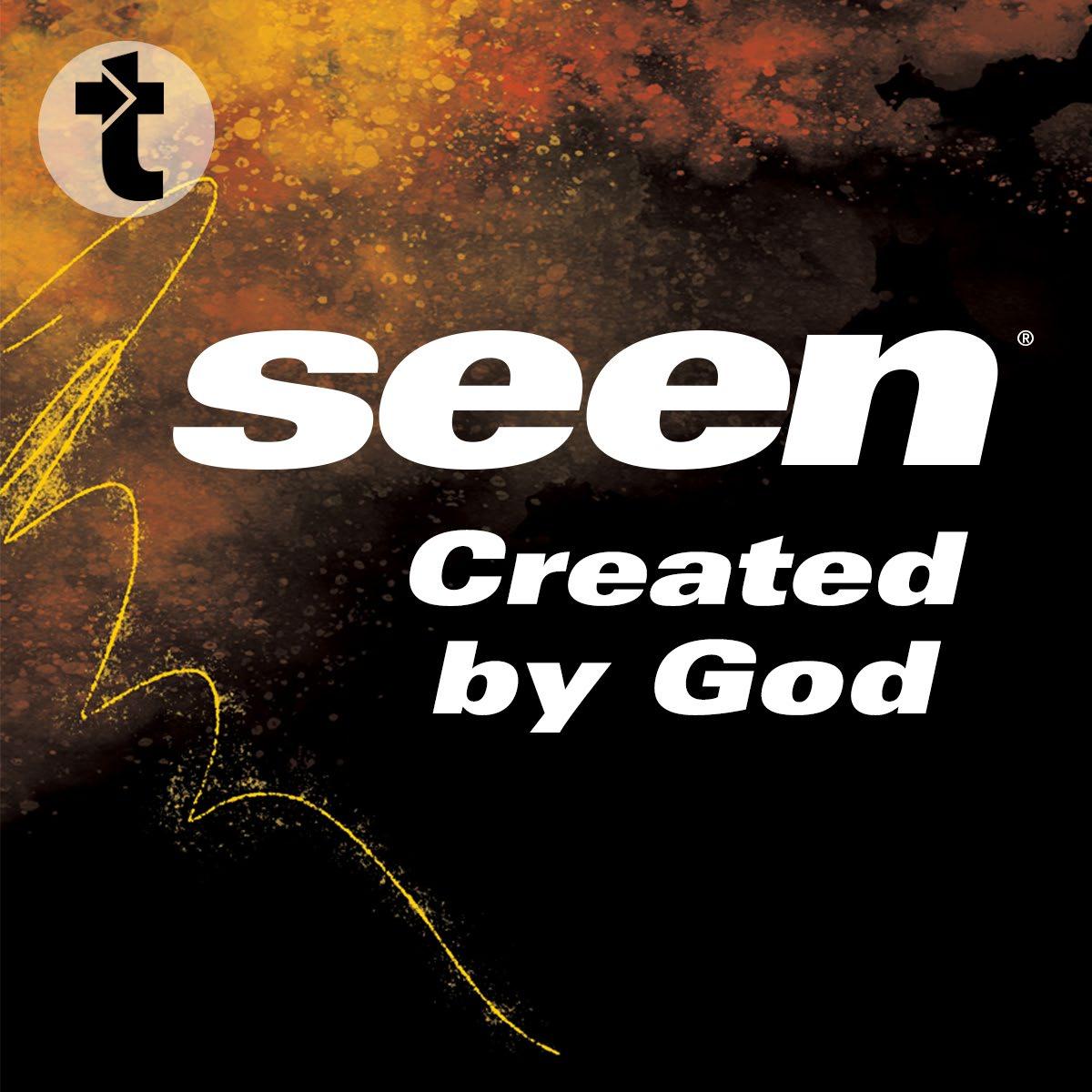

LEADER GUIDE
Find out more about seen at www.davidccook.org/seen.
SEEN® LEADER GUIDE is published quarterly by David C Cook, www.davidccook.org.
Copyright © 2025 by David C Cook, 4050 Lee Vance Drive, Colorado Springs, Colorado 80918, U.S.A. All rights reserved. SEEN® is a registered trademark of David C Cook. #1627825. Printed in Gunpo-si, Gyeonggi-do, South Korea, February–April 2025. Scripture quotations taken from the Holy Bible, New International Version™, NIV™. Copyright © 1973, 1978, 1984, 2011 by Biblica, Inc. Used with permission. All rights reserved worldwide. www.biblica.com
Year 3, Quarter 9
Contributing Writers: Micah Renck.
SEEN Team: Lindsay Black, Laura Derico, Matt Irvine, Melissa Myers, Courtney Weaver, Sharon Gilbert, Kerri Mills, Byron Ragains. Cover design and Interior design and production: David C Cook Creative Services. Cover photo: Getty Images.
Digital Resources
Enhance your connection to your students with: » video resources for each lesson
» customizable Leader Guide lesson outlines » reproducible student group discussion cards » PowerPoint visuals for each lesson
» memory verse visuals for each lesson
» weekly parent and student connection materials
DEAR LEADER,
“Who am I?” Have you ever asked yourself that question? I’m going to guess that you have. It’s the kind of question that everyone asks themselves at some point—or at many points. As adults, that question often is born of doubt, fear, and stress. But as children, that question can often help us grasp significance and confidence, as long as we build our answer on solid information.


But teens today don’t always have solid information, do they?
That’s where God steps in. And that’s where you come in too, guiding students to understand and maybe to hear for the first time that the God of the universe made them, shaped them, and wanted them from the beginning. That He still wants them today. And that no matter who they are or what they’ve done or what kind of identity they have decided to claim for themselves, He loves them just as they are and promises to keep loving them until they are the best version of them that they could ever imagine being, and even better than that. Because, let’s face it, when it comes to what God is capable of doing, our imaginations just don’t even begin to grasp that.
I know it’s easy—so easy!—to get distracted by a million concerns when you are teaching teens. I know it’s hard to balance your priorities and goals in ministry along with the needs and interests of even the smallest group of students. However, the stuff in this quarter is important, and it’s worth spending time on. Because here’s the thing—no matter what kind of lives these students are subjected to in their homes or schools or neighborhoods, if one trusted adult can just show them in all sincerity that their true identity is found in Christ, that small seed of truth and faith will not die. It will grow and keep growing, even through adversity, and it will eventually help that student to become who God has created them to be. No doubt about it.
I’m excited for you. You get to help these students understand that all humans were created by God, that our identity is found in Him, and that He is a never-ending source of strength and confidence and healing, who can repair and build up our self-esteem like no one else can. Who are you? You’re the person who gets to give students that message. You’re the person God has trusted to shepherd these young lives along important steps of their journey. And oh by the way, you’re His child too. How amazing is that?
As you lead and teach these amazing truths, let us know how it goes for you. Our hope is that the materials we’ve provided help you get the message across, but we know we can always improve. So, let us hear about it! Go to the website listed on the contents page to find out how to contact us. Get in touch. We’d love to hear from you, and we’d love to know better how to pray for you and your students.

How to Use This Guide
Let’s take a look at the anatomy of this discussion-based curriculum. Three units make up each quarter, or module. One unit is focused on spiritual growth, one is focused on character development, and one is focused on practical skills for life. But to be clear—solid Bible study, Christian principles, and practical life application are built into every lesson.
Each unit is made up of four sessions in which essential principles are wrestled with and discussed through a biblical worldview. There are twelve lessons in each quarter. We also provide two special lessons for winter and two for spring quarters*—these are digital lessons that are provided in Digital Resources and can be used at the times that work best for your ministry.
SPIRITUAL GROWTH
CHARACTER DEVELOPMENT
LIFE SKILLS UNIT 3
LESSON SECTIONS
Teens learn who they are in the world and in Christ.
Teens learn how to live like they know who God is and who they are in Christ.
Each lesson has a certain structure, which you can use as-is or customize for your needs. Please note that suggested leader remarks to the students have been provided in bold throughout the guide for you to use or adapt as you wish.

On the lesson header page, you’ll find the unit focus (Ex: Spiritual Growth), unit title, lesson title, and lesson Scripture focus. You’ll also immediately see the Connection point—the main message of the lesson.
In the margins you’ll see information such as the supplies list and leader tips. Leader tips are provided throughout the sections of the lesson.
REMEMBER: Challenge your students to memorize a verse each week. A graphic of this verse (or verses) is also included in Digital Resources and a memorization exercise is provided in their Student Guides
PREP: Think over the concepts presented in the lesson. Pray about your approach to the material and ask God to help you make solid connections with your students.
LEADER’S BIBLE NOTES: Look here for a summary of helpful Bible background notes or issues to look out for as you teach the lesson. Also notice the overview of the lesson, which reminds you of the overall framework.
PREVIEW: This is an activity or conversation starter that gives a glimpse of the main idea of the lesson. You also have the option of using a lesson intro video (provided in Digital Resources) as an attention-getter or discussion-starter to get the group thinking and talking.



CONNECT: This is the main teaching section of the lesson—when you’ll lead students through a study of portions of the Bible. There’s also an option to “flip the classroom” and let students lead their own small groups through part of the Bible study (take note of the Leader Tip and marked paragraphs that guide you to invite students to lead discussion). Notice also the ZOOM QUESTIONS in this part of the lesson. These are questions designed to take the discussion a little deeper for those students who are ready to do so.
EXPLORE: In this section, give students a chance to interact with what they’ve learned or to express their thoughts. If you include worship as part of your youth teaching time, this is an excellent spot to add songs or prayers or time for reflection. Students may be invited to use their Student Guides to jot down thoughts and images that help them to process what they are learning.


ACT: Leave students with a few ideas of ways they can apply this lesson to their own circumstances or practice what they’ve learned throughout the week. Here they might be invited to take on a prayer challenge, talk to someone about God, ask a parent a question, search more in the Bible, or perform other actions. You’ll also see that every lesson ends with a brief prayer you can pray over your students and some reminders for ways you can connect with your students or their families.
For lesson information from more quarters, check out the scope and sequence provided on the curriculum website, as shown on the Contents page.

FURTHER RESOURCES
You’ll discover three articles in this guide that offer information and ideas that will be relevant to the corresponding unit material. These articles will provide some more context to a wide variety of issues, such as what it means to live in God’s image, how identity is defined, or how to develop healthy selfesteem.
We also offer the accompanying Digital Resources (separate product), which include
• video resources for each lesson
• customizable Leader Guide lesson outlines
• reproducible student group discussion cards
• PowerPoint visuals for each lesson
• memory verse visuals for each lesson
• weekly parent and student connection materials
We encourage you to find out more about this curriculum and other tips and tools at the website listed on the Contents page.
And remember! We value you and your insights. Please contact us and let us know how we can serve you. Our goal is to help you help more teens come to know God better every week.
Teens are under an enormous amount of stress these days. They are feeling pressure from more and more directions, and we know you are too. You are making a difference in their young lives, and we would love to pray for you and partner with you as God brings about transformation through your ministry.
*PLEASE NOTE: If you use this curriculum as a year-round option and use the free, downloadable lessons provided for winter (about Jesus’ birth) and spring (about Jesus’ death and resurrection), those two quarters will have more sessions in them than the others (see sample plan below).
This structure may be new to those who are more familiar with 13-lesson quarters. Please keep this in mind as you plan your programming calendars and your ordering schedule.
Summary
Unit 1 // Spiritual Growth Created

by God
Understanding that God created us is the first piece of the puzzle that reflects our identity. With that understanding comes the realization that we were all made by God for a purpose and that each one of us has strengths and gifts that God put inside us to accomplish His purposes. Because we are all made, all gifted, and all loved, we can love and honor one another.
LESSON 1: Created Male and Female
LESSON 2: Honoring One Another
LESSON 3: God Works Through All People
LESSON 4: Standing Together for God
Unit Video
You’ll find a teaser to some of the questions and themes we will be discussing in the Q9U1 Intro video, available in Digital Resources. You may want to use this in various ways:
• Show it to your leaders and have an in-person, online, or text discussion about the themes before you begin the unit.
• Send it to parents to introduce them to the unit material.
• Show it during the first lesson of the unit to introduce your students to the concepts.
Unit Resources
• “Reflecting God’s Image,” p. 42
• My ID, inside back cover
• Salvation Path in Digital Resources
• Special Needs Solutions in Digital Resources
• What to Do If You See Abuse in Digital Resources

Created Male and Female Spiritual Growth Created by God
Quarter 9 Unit 1 Lesson 1
Genesis 1:27; 2:18-24; Galatians 3:26-29

God created males and females in His image.
REMEMBER
“So God created mankind in his own image, in the image of God he created them; male and female he created them.”
Genesis 1:27
PREP
God created all people in His image. Each person has been made to resemble God—in how we think, act, and share our lives with others. Our God reasons, creates, loves, and communicates, and He designed each of us to do the same.
God gave these incredible gifts to all people: to male and female alike. However, sometimes men and women are treated differently in different settings. Think about your own community. How are women seen and treated? How are men seen and treated? What rights and restrictions and expectations are placed on them? Have you ever thought much about the source of your ideas about how men and women should be? As you prepare to teach this lesson, ask God to show you how much He loves and values both women and men. Think about your own views and ask God to help you to teach students thoughtfully about how to value one another as God’s beloved creation.
SUPPLIES
Bibles
Digital Resources
Student Guides
whiteboard, dry-erase markers pens or pencils or markers paper
LEADER TIP
A graphic of the Remember verse is provided in Digital Resources for every session, along with other resources, including a PowerPoint template for you to customize to help lead the session time.
LEADER’S BIBLE NOTES
Since the beginning of time, God decided both male and female were essential to creation. In the story of the creation of the world in Genesis, both the man and woman had important roles. They both had a close relationship with God. And even after they disobeyed God, they together created a family and, eventually, a community.
It’s interesting to see in Genesis 2 that God knew that Adam should not be alone but also that his need for a companion could not be met by any other kind of creature. He needed the one who was bone of his bones and flesh of his flesh. But he also needed someone who was something other than himself—not just a copy of himself, but different. Created differently, with a different mind and body, a different way of thinking and doing things. We might imagine a world filled with perfect clones. But humans need something more. We need both a common foundation and a sense of otherness. When men and women work together in good relationship and community, the image of God is accurately reflected in the world. Help your students to think about what they can learn about God through thinking about how He created male and female people. What can we see that is good about masculine and feminine qualities? Why are the two needed to reflect the whole image of God?
OVERVIEW

LEADER TIP
As you discuss male and female characteristics, be careful to examine stereotypical representations in a thoughtful way. Ask questions and listen to what your students say.
Preview: Give a glimpse of today’s Connection point. Connect: Analyze what the Bible says.
Explore: Hear what students have to say.
Act: Give students something to do.
PREVIEW
Greet students by name. Use the U1L1 video as students arrive to spark discussion or attract attention. You can also invite them to participate in an activity.
Invite your students to pair up. If you have an odd number of students, you or other leaders can act as partners for teens. Ask students to stand facing each other, about three steps apart. One partner will be the “leader.” The other will be the “mirror.”
In each pair, the leader will make simple movements, such as waving an arm or tapping a foot. The mirror student will follow the leader’s movements exactly, as a mirror reflection would. The goal is to mirror the leader perfectly. Give students about one minute to play. Then have the pairs switch roles, so the leader becomes the mirror and the mirror becomes the leader.
LEADER TIP
Encourage the “leaders” to keep their movements slow, smooth, and continuous, rather than abrupt. And be on the lookout for any students choosing to make inappropriate gestures.

LEADER TIP
Encourage students to bring their Bibles or to use Bible apps on their phones. Excerpts of the Scripture with each lesson are also provided in the Student Guides.
LEADER TIP
It’s possible that some of your students struggle with their gender identities. Rather than making students feel ashamed or outcast, reinforce that all people are made in God’s image and loved deeply as His image bearers.
Teens can repeat this activity with different partners as time allows before you transition to the Connect teaching time.
CONNECT
The images we see in a mirror look just like our physical bodies. But there are parts of us we can’t see—parts that make us like the One who created us, such as our brains, personalities, and souls. We’re all created in God’s image.
Listen to what Genesis 1 in the Old Testament teaches us about being created in God’s image.
Ask a student to read Genesis 1:27 out loud:
So God created mankind in his own image, in the image of God he created them; male and female he created them.
Who did God create in His image?
What do you think it means to be created in the image of God?
In what ways do you think people are like God?
ZOOM QUESTIONS
What qualities in yourself do you think reflect God’s image? If you see each person as being formed in the image of God, how do you think that could affect your feelings toward each person? Are there parts of yourself that you feel separate you from God’s image? How so?
If we read some other verses in Genesis 1, we’ll see that God created humans to rule over all the other creatures. He tells them how He is providing for them. And He commands humans to “be fruitful and increase in number; fill the earth and subdue it” (v. 28).
What qualities do humans need to be good rulers over all creation?
How would you describe God’s relationship with His creation? How do humans reflect or not reflect this relationship?
What do plants and animals need in order to “be fruitful and increase in number”? How are human needs different from those of plants and animals?
When the Bible tells us that God made humans in His image, it means we’re a reflection of Him, like our images in the mirror reflect us. Another way to think about it is like an artist creates a portrait or sculpture of a person. The piece of art is not the same as the real person, but it combines different aspects of the person into a whole piece that can be identified as looking like or reminding us of that person in some way. Masterful portraits often guide us to appreciate what’s beautiful or interesting about the actual person.
In a similar way, God has created in us qualities that, when we cultivate them and use them, may lead others to see what’s beautiful and interesting about our Creator.

Like God, we can think, create, and communicate. Also like God, relationships are important to us. We don’t do well if we are left on our own for too long. We need other people to help us be complete, fully functioning, and healthy human beings.
Unfortunately, in many cultures and societies, some people are valued more highly than others. And how we treat people is based on how we value them. People with different physical or mental abilities are sometimes treated as though they have lesser value. People from certain ethnic groups, nationalities, genders, and social groups may be treated as though they have less significance. But we’re all made in the image of God. We are all equally loved and valued by Him.
When we think about different genders in particular, certain stereotypical images may come to mind. But let’s break this down and think about our views and where they come from.
What are some particular qualities that come to mind when you think about what it means to be female?
What are some particular qualities that come to mind when you think about what it means to be male?
You’ll notice in Genesis that God does not say “Let’s create tall, strong men, who have facial hair and muscles and don’t ever talk about their feelings.” Nor does He say, “Let’s create beautiful, delicate women who talk a lot and like to go shopping.” In fact, you can look through the whole Bible (go ahead—I dare you!) and you won’t find any descriptions of what an ideal man or woman looks like.
*But we can notice a few things about what God says in Genesis about men and women.
Ask a couple students to take turns reading Genesis 2:18-24 out loud:
The Lord God said, “It is not good for the man to be alone. I will make a helper suitable for him.”
Now the Lord God had formed out of the ground all the wild animals and all the birds in the sky. He brought them to the man to see what he would name them; and whatever the man called
LEADER TIP
Depending on your group, you may want to acknowledge that some people do not identify as either male or female but think of themselves as occupying various spots on a spectrum of gender concepts. But for purposes of this discussion, we’re going to evaluate traditional gender categories.
LEADER TIP
If you can, use a whiteboard and divide it into two columns for “male” and “female.” Invite students to write their answers to these questions on the board.
LEADER TIP
*If you choose to use small groups, pause before the marked paragraph and allow students to lead this portion of the teaching in small groups. Students can use the Student Guide View pages or the Your View cards as provided in Digital Resources. If you use this option, skip forward to the starred paragraph (**) after the small-group time concludes.

LEADER TIP
Though this translation of Genesis 2:18 can feel like a woman’s role is subservient, the actual wording indicates women as suppliers of strength. Reinforce to teens that Scripture isn’t feeding a gender stereotype but is instead indicating the essential strength and value of women in creation.
each living creature, that was its name. So the man gave names to all the livestock, the birds in the sky and all the wild animals.
But for Adam no suitable helper was found. So the Lord God caused the man to fall into a deep sleep; and while he was sleeping, he took one of the man’s ribs and then closed up the place with flesh. Then the Lord God made a woman from the rib he had taken out of the man, and he brought her to the man. The man said, “This is now bone of my bones and flesh of my flesh; she shall be called ‘woman,’ for she was taken out of man.”
That is why a man leaves his father and mother and is united to his wife, and they become one flesh.
God created the woman to be a “suitable helper” for Adam. In the original language of the Old Testament, this term helper means “one who supplies strength,” and it’s used almost exclusively about God, as the One who helps and saves His people.
God created Eve to be a helper to Adam by providing the things he lacked. Adam was also supposed to provide for Eve the things she lacked. Both shared the image of God, and both were created to meet the needs of the other. Both were equally important.
Why do you think God created men and women differently?
In what ways do males and females provide things that the other lacks?
What does the fact that God created two distinct beings say to you?
What does it mean to you that God created these two beings to need each other?
What does the fact that both maleness and femaleness are part of God’s image say to you?
ZOOM QUESTIONS
How do gender stereotypes hurt the relationships and connections that might otherwise exist between men and women? How do gender characteristics help us understand relationships and connections between men and women? In some parts of society today, the idea of “gendering” things has become taboo (for example, having “girl” toys and “boy” toys). What about the concepts of gendered roles or characteristics do you think can be unhelpful or uncomfortable for some people? What about these concepts can be helpful or encouraging for people (for example, think about concepts such as “girl power” or “men of honor”)?
**Allow teens to share their thoughts. Guide students to think of character traits and roles that are common for men and women. Help them to see that these skills and traits complement each other and allow men and women to help each other.
Besides being created by God and in His image, the Bible also tells us that women and men are equal heirs to God’s promise of salvation.
Read Galatians 3:26-29:
So in Christ Jesus you are all children of God through faith, for all of you who were baptized into Christ have clothed yourselves with Christ. There is neither Jew nor Gentile, neither slave nor free, nor is there male and female, for you are all one in Christ Jesus. If you belong to Christ, then you are Abraham’s seed, and heirs according to the promise.

LEADER TIP
Remind students that an heir is someone who inherits something of value.
What do these verses tell us about who’s valued by God?
What does it mean to be a child of God through faith?
How does becoming “clothed” with Christ affect our identity in God’s sight?
How might being clothed with Christ affect our identity in the view of the world around us?
To be clear, becoming a child of God does not erase our personalities, nationalities, or other parts of our identities. But being an heir of salvation means we are all given equal standing before God. God loves us all and offers grace to everyone, regardless of our ethnicity, social class, or gender. He doesn’t love some of us more because of who we are or where we were born. And He accepts us all, no matter what anyone else thinks.
In fact, God loves and values us so much that He sent His Son to pay the price for our sins—not just the sins of some, but the sins of all! Jesus died for all people. And God invites all of us to receive salvation and become His children.
EXPLORE
Invite teens to do the following activity in their Student Guides. (If you have them, distribute markers at this time.) If you still have the list of male and female characteristics on the board, ask students to reference that list. If you don’t have that reference, ask students to make their own lists of male and female characteristics. Lead students in a prayer/writing exercise.
As you think about the different characteristics of men and women, write down the qualities that you see as being strong or positive. It may help you to think of a
LEADER TIP
If students have questions about becoming a Christian, invite them to speak with you after class. Make yourself available to answer questions, pray with students, and listen to their stories. You can also use the Salvation Path tool in Digital Resources as a guide.

person (or persons) who has those qualities. Then make those words on your page look stronger and emphasize them—you may do this by coloring the words or tracing over them, or decorating them in other ways. As you highlight each word, ask God to help you think about how you could develop that quality more in your life. Ask God to help you see the value of that characteristic more clearly. And thank God for the examples of that quality in people you know.
For example, if the characteristic is courage, you could ask God to give you opportunities to face fears or to grow braver. You might also think of a particular situation in which you’d like to be more courageous and ask God to help you with that situation. And you could think of courageous people you know or have seen in your community and thank God for those people.
Give the students time to pray over these qualities before moving on to the next section.
ACT
Some people may value men and women differently because of certain views linked with gender, but this doesn’t line up with God’s message to us through His Word and through His Creation. God loves all people equally—He’s created both men and women with special talents, strengths, and gifts. And He intends to use both men and women to accomplish His purposes. God has also given both men and women the opportunity to receive His promise of salvation. No one will be refused admission to the kingdom of God because of their gender.
We reflect the image of God when we care for His creation—all parts of it. We reflect His image when we value one another equally as His created beings. We reflect His image when we honor the distinctive characteristics that He gave us and when we work at building relationships with each other, despite our differences. We reflect His image when we, through faith, become children of God and clothe ourselves with Christ.
As you go through your week, think about these things:
• Think about how God has made you different from others. Thank God for those differences.
• Think about the distinctions between males and females. Praise God for what we can discover about Him through seeing these two types of human beings.
• Think about the way males and females are made stronger through their relationships with each other, whether as friends, family members, or as spouses.
• Think of ways you can value yourself as God does. Thank God for loving you and inviting you to be part of His family.
Before you head out this week, let me pray for you: God, our loving Creator, remind us that all people are equal in Your eyes. Help us to love others like You do and to value each person as someone created in Your image. Thank You for the promise of Your salvation, in Jesus’ name, amen.
Reminders for you: In the Student Guide are suggestions for verses for further study. Remind students that they can contact you during the week if questions come up about anything they heard today. If students express interest in making a commitment to follow Christ, see the Salvation Path tool in Digital Resources for help in guiding them through this decision concerning repentance and baptism.

In Digital Resources you’ll find Family Connection tools and Student Connection helps for reaching out to your students during the week as well. Remember to let students know that you (or other leaders) are available to speak to them or to their family members if they need more information or would like you to pray with or for them. Be aware that conversations with teens in difficult situations may result in finding out about instances of abuse or neglect. Know your legal reporting responsibility—check out the What to Do If You See Abuse tool in Digital Resources
LEADER TIP
An important part of deepening your relationships with your students is ending your class time by praying over them. We’ve provided biblically based statements you can use as prayers, or you may want to create your own to remind teens of who God is, what He wants for them, and how to connect with Him.

seen STUDENT GUIDE
UNIT 1
Created by God
Lesson 1 Created Male and Female .................................................
Genesis 1:27; 2:18-24; Galatians 3:26-29
Lesson 2 Honoring One Another
Mark 16:1-11; John 4:1-42; 12:1-8; Romans 12:10
Lesson 3 God Works Through All People
Acts 9:36-42; 16:14, 15, 40; 1 Thessalonians 5:12, 13
Lesson 4 Standing Together for God
Ruth 1–4
UNIT 2 Identity
Lesson 5 Who Am I?
2 Corinthians 5:16-21; Galatians 4:1-7; 1 Peter 2:9; 1 John 3:1, 2
Lesson 6 Who Knows Me? ...................................................
Lesson 7 What Is Threatening My Identity?
1 Corinthians 10:1-12
Lesson 8 How Can I Protect My Identity?
John 13:34, 35; 1 Corinthians 10:13-33; 1 Peter 2
UNIT 3
Self-Esteem
Lesson 9 Healing Old Wounds .............................................
Psalms 7, 73; Isaiah 61:1-3
Lesson 10 Seeking Protection
Psalms 25; 33:12-22; Proverbs 4
Lesson 11 Knowing Reasons to Be Strong
Esther 1–10; Romans 8:28
Lesson 12 Trusting God with Our Needs
Isaiah 43:1-7; Mark 5:21-43
Follow us on Instagram @seenstudents for inspiring messages and images.
SEEN® STUDENT GUIDE is published quarterly by David C Cook, www. davidccook.org. Copyright © 2025 by David C Cook, 4050 Lee Vance Drive, Colorado Springs, Colorado 80918, U.S.A. All rights reserved. SEEN® is a registered trademark of David C Cook. #1627525. Printed in Gunpo-si, Gyeonggi-do, South Korea, February–April 2025. Scripture quotations taken from the Holy Bible, New International Version™, NIV™. Copyright © 1973, 1978, 1984, 2011 by Biblica, Inc. Used with permission. All rights reserved worldwide. www.biblica.com
Year 3, Quarter 9
Contributing Writers: Micah Renck.
SEEN Team: Lindsay Black, Laura Derico, Matt Irvine, Melissa Myers, Courtney Weaver, Sharon Gilbert, Kerri Mills, Byron Ragains. Cover design and Interior design and production: David C Cook Creative Services. Cover photo: Getty Images.


welcome
“Who am I?” is a question that’s been asked so often, it’s become a little bit tired, like an old meme only your parents use anymore. But the truth is, we all ask ourselves this question at some point or another. And if we don’t do it, you can be sure that there will be some career or college counselor who will ask it, and then they’ll want you to fill out a 585-question survey to answer it.
Don’t worry, there are no surveys in this guide. And we don’t even want to know your answer. In fact, no one’s even saying you should have a complete answer for that question right now. You’ve got lots of time to figure that out. You’re a thing in process, and that’s OK. But the one thing we do want you to be sure of is whose you are. Maybe there will be something in these pages that helps you sort that out.
“Do not fear, for I have redeemed you, I have summoned you by name; you are mine.”
Isaiah 43:1b

How to Use this Guide
In each lesson you’ll find these parts:
VIEW: Here you’ll see a summary of the lesson’s main message and some questions to help you think about it. You may also want to use these questions with your small group.
YOUR TAKE: Jot down thoughts or images from what you’ve learned that you want to remember.
REMEMBER: Challenge yourself to memorize a part of God’s Word.
YOUR STORY: Think about something you’ve learned that is meaningful to you and your faith journey, or think about how something in your life fits in well with the lesson.
OWN IT: Dig into God’s Word for yourself and find out even more about the main point of the lesson.
SEARCH: Spend time searching for related topics in God’s Word. What do you feel or think in response to what you see in the Bible?
You can also use any of these pages to write down questions you have or things you want to pray about. Text or talk to one of your leaders whenever you want to discuss something that you don’t understand or something you want to learn more about. Talk to your friends too. Sometimes a simple question can lead to a life-changing conversation.

Unit 1 // Created by God

Understanding that God created us is the first piece of the puzzle that reflects our identity. With that understanding comes the realization that we were all made by God for a purpose and that each one of us has strengths and gifts that God put inside us to accomplish His purposes. Because we are all made, all gifted, and all loved, we can love and honor one another.
Lesson 1: Created Male and Female
Lesson 2: Honoring One Another
Lesson 3: God Works Through All People
Lesson 4: Standing Together for God


Created by God
Created Male and Female
Quarter 9 Unit 1 Lesson 1
Genesis 1:27; 2:18-24; Galatians 3:26-29


God created males and females in His image.
REMEMBER
Genesis 1:27
“So God created mankind in his own image, in the image of God he created them; male and female he created them.”
VIEW

We’ve been talking about how God created us in His image, male and female. You can look through the whole Bible (go ahead—I dare you!) and you won’t find any descriptions of what an ideal man or woman looks like. But you can notice a few things about what God says in Genesis about men and women.
Read Genesis 2:18-24:
The Lord God said, “It is not good for the man to be alone. I will make a helper suitable for him.”
Now the Lord God had formed out of the ground all the wild animals and all the birds in the sky. He brought them to the man to see what he would name them; and whatever the man called each living creature, that was its name. So the man gave names to all the livestock, the birds in the sky and all the wild animals. But for Adam no suitable helper was found. So the Lord God caused the man to fall into a deep sleep; and while he was sleeping, he took one of the man’s ribs and then closed up the place with flesh. Then the Lord God made a woman from the rib he had taken out of the man, and he brought her to the man.
The man said,
“This is now bone of my bones and flesh of my flesh; she shall be called ‘woman,’ for she was taken out of man.”
That is why a man leaves his father and mother and is united to his wife, and they become one flesh.
God created the woman to be a “suitable helper” for Adam. In the original language of the Old Testament, this term helper means “one who supplies strength,” and it’s used almost exclusively about God, as the One who helps and saves His people.
God created Eve to be a helper to Adam by providing the things he lacked. Adam was also supposed to provide for Eve the things she lacked. Both shared the image of God, and both were created to meet the needs of the other. Both were equally important.
• Why do you think God created men and women differently?
• In what ways do males and females provide things that the other lacks?
• What does the fact that God created two distinct beings say to you?
• What does it mean to you that God created these two beings to need each other?
• What does the fact that both maleness and femaleness are part of God’s image say to you?
YOUR TAKE
What is your takeaway from the Bible concept, stories, or things you discussed with your group?

REMEMBER
Fill in the blanks to help you learn the Remember verse (shown on the first page of this lesson):
“So God created __________________ in his ___________ _______________. in the _________________ of God he ____________________ them; _____________ and _______________ he __________________ them.”

YOUR STORY
God created in us qualities that, when we cultivate them and use them, may lead others to see what’s beautiful and interesting about our Creator. Take some time to think about this: What are some qualities in you that reflect the image of God? Make a list, draw a collection, or write about those qualities here.
OWN IT
Look at the lists of male and female characteristics that your group made or, if you don’t have that available, create lists of your own. As you think about the different characteristics of men and women, write down the qualities that you see as being strong or positive. It may help you to think of a person (or persons) who has those qualities. Then make those words on your page look stronger and emphasize them—by coloring the words or tracing over them, or decorating them in other ways. As you highlight each word, ask God to help you think about how you could develop that quality more in your life. Ask God to help you see the value of that characteristic more clearly. And thank God for the examples of that quality in people you know.

For example, if the characteristic is courage, you could ask God to give you opportunities to face fears or to grow braver. You might also think of a particular situation in which you’d like to be more courageous and ask God to help you with that situation. And you could think of courageous people you know or have seen in your community and thank God for those people.

SEARCH
Read Genesis 1 and 2 in the Old Testament. Write or draw your own discoveries about what Scripture tells us about the creation of people.
MY ID
Who does God say I am? Find out by reading these Bible verses.
John 1:12, 13
Romans 8:37-39 1 Peter 2:9, 10
Romans 8:14-17
1 Peter 2:4, 5 1 Corinthians 12:27
2 Corinthians 5:20, 21
Ephesians 1:4-6
Psalm 139:13, 14
Philippians 3:20, 21 Galatians 3:26-29 John 3:16, 17
Genesis 1:27 Colossians 3:12
Ephesians 2:10 1 John 3:1, 2


“You are a chosen people.”
1 Peter 2:9a

DIGITAL RESOURCES INCLUDE
» Video resources for each lesson
» Customizable Leader Guide lesson outlines
» Printable student group conversation cards
» PowerPoint visuals for each lesson
» Memory verse visuals for each lesson
» Weekly digital family connection materials
» Weekly digital student connection materials
» Youth curriculum logo graphics

Welcome to Digital Resources! We hope the materials we’ve developed will provide you with everything you need to create a successful learning experience for your students. Please follow the directions to access Digital Resources.
HOW TO USE THESE MATERIALS
For best results, download Digital Resources to a desktop computer, rather than to a mobile device.* Be aware that the files could take a few minutes to finish downloading, depending on your connection speed.
Step 1
Locate the Access Code within this card (under the ACCESS CODE heading). Don’t lose it! Take a picture of it or put it in a safe place so you can retrieve it, if needed. Please do not share the code with other ministries.
Step 2
Open your favorite Internet browser. Go to http://Lesson-DL.com by typing this link exactly in your Internet browser window.
Step 3
When the Lesson-DL.com web page opens, you will notice a small window on the page with space to enter the 9-digit Access Code. Type in the Access Code and choose “Submit.” Be sure to carefully type in all 9 numbers.
Step 4
When you click on “submit,” the download will begin. This download is delivered as a zipped folder (.zip). Once the downloading process has finished, locate the folder, which will begin with the title “DigitalResources.” Open the folder by double-clicking on the folder icon or title. It should then “unzip” for you and create a separate folder with the same

name in the same location. If you have any trouble, contact customer support via the chat feature on the website. Once the separate folder is visible, you may open that folder by double-clicking on it.
Step 5
Within this Digital Resources folder, you will find these subfolders:
» 01 Lesson Materials
» 02 Videos
» 03 Connection Materials
» 04 Graphics
Explore the contents of these folders and reference your Leader Guide and the Student Guide to gain a better understanding of how each lesson works.
Step 6
For more information, a sample lesson, and a walkthrough video, go to www.davidccook.org/seen.
Step 7
Rest. God did; so should you! Pray about the coming quarter and thank God for the opportunity to reach a generation with His Word!
* While it is possible to download a .ZIP compressed file to a mobile device, you may need to install a helper App first, like UnZip or WinZip. Check the Apple App Store (iOS) or the Google Play Store (Android) for a suitable app. Search for “Zip file opener”.

YEAR 3 • QUARTER 9 ACCESS CODE
REMEMBER:
1. Keep this access code in a safe place. You will need it if you need to redownload materials for any reason.
2. Please do not share this code with any volunteers or staff outside of your ministry.
3. Be aware that the access code is unique each quarter. You will need to order a new Digital Resources access card for each quarter.


READ THIS FIRST
BEFORE YOU OPEN THIS CARD, be aware that revealing the Access Code contained within indicates acceptance of the product and the downloadable materials. Once the Access Code has been revealed, the product is not returnable . To learn more before opening the card, please review the samples of the downloadable Digital Resources provided at www.davidccook.org/seen . The Access Code and license to use these materials is good for 12 months from the date of purchase and may be shared—at no additional cost—with up to 5 leaders of a single class at a single site. If you encounter any problems with using the link or downloading the materials, please utilize the customer support chat feature on the website.


Created by God

Created Male and Female Lesson 1

CONNECTION: God created males and females in His image
SCRIPTURE: Genesis 1:27; 2:18-24; Galatians 3:26-29
SUPPLIES TO GET
(NOTE: In the Lesson Outlines supply lists, we only list items needed outside of the curriculum resources and Bibles.)
whiteboard, dry-erase markers pens or pencils or markers, paper
REMEMBER
“So God created mankind in his own image, in the image of God he created them; male and female he created them.”
Genesis 1:27
PREVIEW
• Use the U1L1 video.
• Do the mirroring activity.
CONNECT
• Introduce the concept of people being created in the image of God.
• Read the provided Scriptures from the Connect section
• Focus on the idea that God created all people to be a reflection of Him in the world.
• Guide students to understand that God created all of us, and He loves all of us equally regardless of our gender.
*Don’t forget to
• use the ZOOM QUESTIONS to go deeper with older/more mature students.
• use the Student Guides or the Your View Conversation Cards to let students lead each other through part of the lesson.
EXPLORE
• Instruct students to read the provided Bible verses and respond to the prompts
• Reflect on the provided Bible verses.
*Don’t forget to use this time for worship together, if desired.
ACT
• Give students some closing thoughts and challenges to take them through the week.
*Don’t forget to
• use the Family Connection materials provided on Digital Resources to connect with parents and caregivers about what the students are learning.
• use the Student Connection materials to connect with students throughout the week.

CONNECTION: God created males and females in His image.
TEXT THIS BEFORE THE LESSON
When you look in a mirror, what do you see?
What do you think it means that you’re created in God’s image?
Come find out how people are made in God’s image!
Look up what imago dei means.
TEXT THIS AFTER THE LESSON
YOU are made in God’s image!
What could it look like to value other people as God’s creations ?
What does it tell you about God that He says we’re all one in Jesus?
God invites all of us to receive salvation and become His children.
SOCIAL MEDIA
Look in the social media folder for images and the Remember verse you can send or post to your students.
VIDEO CHALLENGE
Want to give your students something useful to do with their phones? Challenge them to interview friends and find out their answers to this question: Why do you think God created people the way that He did? Let some of them show their videos at the beginning of the lesson or encourage them to post the video on your group’s social media connection page with the hashtag #CreatedByGod.

CONNECTION: God created males and females in His image. Use these text messages to reach out to the families of your students.
TEXT THIS BEFORE THE LESSON
Starting a unit on being created by God! Can’t wait to see your teen there!
TEXT THIS AFTER THE LESSON
Ask your teen what it means to be created in the image of God.
Ask your teen what they thought about the story of God creating men and women
Ask: How can you reflect God’s image in the world?
Praying for you to have powerful conversations with your teen.

Main Message: God created males and females in His image. Main Scripture: Genesis 1:27; 2:18-24; Galatians 3:26-29
5 THINGS TO KNOW FROM THIS LESSON
• This week begins a new Spiritual Growth unit focused on how people are created by God in His image
• When the Bible tells us that God made humans in His image, it means we’re a reflection of Him However, this doesn’t mean we physically look like God or have the same knowledge or abilities He does.
• Like God, we can think, create, and communicate. Relationships are also important to God, so we’re created to live in community and have relationships with others.
• Scripture message: Some people are at times treated as if they’re less important than others, but we’re all made in the image of God. He loves other people and He loves you! The Bible tells us all people are made to reflect Him
• God created woman to be a helper, providing the things that man lacked. Likewise, the man was supposed to provide for the woman the things she lacked. Both shared the image of God, and both were created to meet the needs of the other. Both were equally important
ASK YOUR TEEN
What does it mean that people are made in the image of God?
REMEMBER VERSE
“So God created mankind in his own image, in the image of God he created them; male and female he created them.”
Genesis 1:27
COMING SOON
Next week, we’ll continue our Created by God unit by talking about honoring one another

“So God created mankind in his own image, in the image of God he created them; male and female he created them.”
Genesis 1:27
